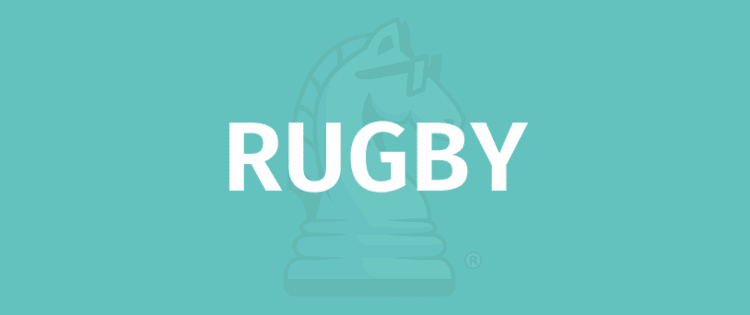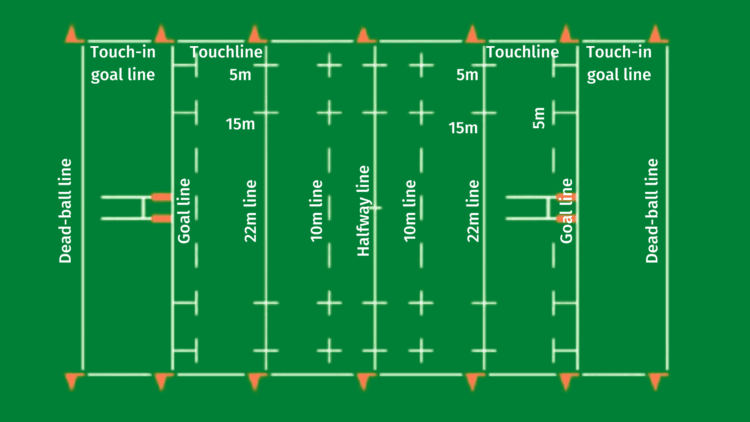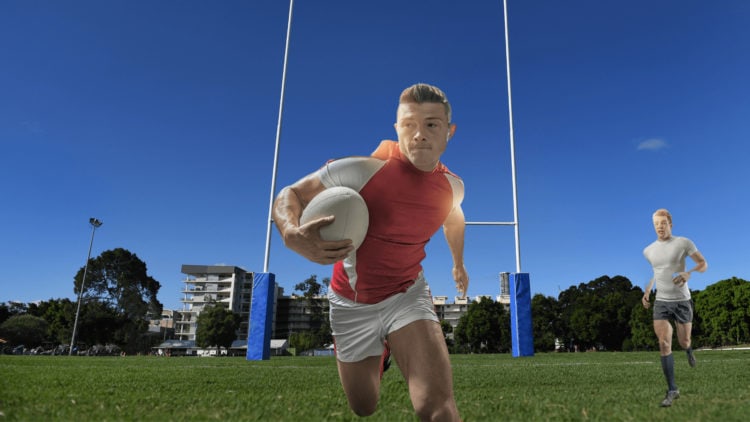
OBJECTIVE OF RUGBY: Score more points than the opposing team by running with, passing, and kicking the ball downfield towards the opponent’s goal area.
NUMBER OF PLAYERS: 30 players, 15 per team
MATERIALS: Rugby ball, cleats
TYPE OF GAME: Sport
AUDIENCE: 6+
OVERVIEW OF RUGBY
Rugby is a sport similar to American football that is generally played in the British Commonwealth. A contact sport that can be incredibly entertaining to watch, rugby can be just as fun to play.
SETUP

FIELD
The rugby field is a rectangular patch of grass up to 100 meters (328 feet) long and 70 meters (230 feet) wide. On top of that, the in-goal areas are either side of the field, which is an additional 6 to 22 meters (19.7 to 72 feet) long. So, the rugby field can be up to 122 meters (400 feet) long.
You’ll see two types of line markings on a rugby field: solid lines and dashed lines.
Solid lines indicate:
- Halfway line
- 22-meter lines
- Touchlines
- Dead-ball lines
- Touch-in goal lines
- Goal lines
Dashed lines indicate:
- 5-meter lines
- 10-meter lines
- 5-meter dash lines
- 15-meter dash lines
The rugby goals are set up on each end of the field on the try lines. The two posts are 5.6 meters (18.4 feet) apart and must be at least 3.4 meters (11.2 feet) tall.
If you don’t have access to a rugby field, you can also play rugby on an American football field, although the dimensions are slightly different.
Players
Each team has 15 players on the playing field. The team is divided into forwards and backs.
Forwards
There are eight forwards in the starting lineup, and they are normally the biggest and strongest players on the team. Forwards are responsible for getting the ball and keeping hold of it.
Hooker: The hooker is a technical player who is good with their hands and feet. This player is responsible for winning possession for his team.
Props: Props “prop up” the hooker during scrums and provide a base for the jumpers during lineouts. Strength and power are their defining attributes.
Locks: The two locks jump during the lineouts to catch the ball or get it on their side of the field. Locks bend directly behind the forward row during scrums to provide a boost for the team.
Flankers: In a scrum, flankers bend on both sides of the locks and behind a prop, providing balance at the edge. Flankers are the most agile and mobile forwards and work to slow down the opposing team.
Number eight: When the game restarts with a scrum, the number 8 usually ends up with the ball. The number eight directs the forwards.
Backs
Backs are generally smaller, more mobile, and more technical players.
Fly-half: The fly-half handles the ball a lot during the game, makes decisions, and communicates to the team on the next step. The fly-half is the team coordinator.
Scrum-half: This player provides the transition between the forwards and backs. He gets the ball from the forwards during set pieces and usually hands it off to the fly-half. The scrum-half also feeds the ball into a scrum.
Centers: The two centers try to break through opposition defenses with the ball using sheer speed and power. Centers can also switch to defense and may tackle attacking players.
Wings: The wings are usually the fastest players on the field. They are good at avoiding tackles and are usually responsible for scoring points by making tries.
Full-back: This player starts behind the backline and is the last line of defense responsible for making last-ditch defensive efforts. The full-back is also good with his feet, kicking balls forward whenever he gets the ball.
GAMEPLAY

A rugby game is divided into two 40-minute halves for a total game time of eighty minutes. There is generally a 15-minute break between the two halves. At the second half of the game, the two teams switch field sides.
KICK-OFFS
A coin toss decides which team starts the match. The match begins with one team dropkicking the ball into the opponent’s half of the field and then going after the ball. The ball must cross the ten-mark line. If it doesn’t, the opposing team gets to choose between a scrum or replaying the kick-off.
POINTS
There are our different ways teams can get points in a rugby game.
Try: Worth 5 points. Players score points by touching the floor of the in-goal area with the ball.
Conversion: Worth 2 points. After a try, the scoring team gets these extra points if they can successfully place and kick the ball through the goalposts.
Drop goal: Worth 3 points. These points are won when players drop and kick the ball through the posts.
Penalty kick: Worth 3 points. Awarded if the opposing team commits a foul. The player must successfully place-kick the ball through the posts.
ATTACKING AND DEFENDING
The team with the ball aims to move the ball forward to score a try. So, the team must make every effort to keep hold of the ball. Attacking players can run in any direction with the ball and kick it forward, but the ball can only be passed backward.
The defensive team attempts to stop the attacking players by grabbing and pulling them to the ground. Rugby is a physical sport with a lot of tackling, and there are a few rules involved to ensure a clean game:
- Tackles must be made from the shoulders down.
- Any player that jumps to receive a ball cannot be tackled until they land.
- Only the player with the ball can be tackled or blocked.
- When tackled, the player must release the ball or pass it to a teammate.
SET PIECES
A set piece is when play resumes after some kind of stoppage of the game.
SCRUM
A scrum can be used to restart a game after a foul.
In a scrum, the eight forwards from each team bend down, arrange themselves in three rows of 3, 4,1 and then wedge themselves against the opposing team. With the wedge in place, the scrum-half of the team awarded the foul rolls the ball into the space between the two wedged teams. The hooker of each team tries to use his legs to get the ball for his team.
The team that gets the ball has two options.
- Push the other team backward, maintaining the scrum shape while keeping the ball in their possession with their feet.
- Pass the ball backward for the number eight and scrum-half so that play can continue.
LINEOUT
A ball that goes out of the playing field on the sidelines results in a lineout. Players from both teams line up 1 meter (3 feet) apart, and the team awarded the lineout throws the ball in between the two teams. Both teams jump for the ball; teammates can boost players up to catch the ball.
PENALTIES
Breaking rules can lead to penalties. These fouls include:
- Tackling above the shoulders
- Collapsing a scrum
- Passing the ball forward
- Not releasing the ball when tackled to the ground
END OF GAME
Whichever team has the most points at the end of the second half wins the game. Rugby games can end in ties, but if a winner must be determined, an extra 20 minutes can be played – teams must switch field sides after 10 minutes.
- 30 GAMES TO PLAY OVER TEXT - April 22, 2024
- 20+ FREE PRINTABLE BABY SHOWER GAMES - April 16, 2024
- 20+ College Party Games for the Best Night Ever! - April 2, 2024